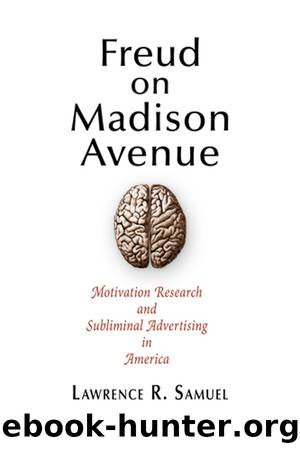Freud on Madison Avenue by Samuel Lawrence R.;

Author:Samuel, Lawrence R.;
Language: eng
Format: epub
Publisher: University of Pennsylvania Press
Published: 2010-08-15T00:00:00+00:00
A Third Communication
With subliminal perception on the ropes, comers from near and far moved in for the knockout. Loyd Ring Coleman, the managing director of J. Walter Thompson in Sydney, Australia, took the time to do the math behind subliminal advertising, pointing out that something smelled rotten in the state of subliminal perception. If the brain could really process two words like âeat popcornâ flashed at one two-hundredth of a second (fifteen times slower than Vicaryâs movie theater blinks, giving him a big benefit of the doubt), it could handle four hundred words a second or twenty-four thousand words a minute. Using these figures, someone could read a novel of average length (seventy-two thousand words) in three minutes, something clearly impossible even for a graduate of Evelyn Woodâs speed reading course. Likewise, Coleman figured, at this same rate a semesterâs worth of lectures could be recorded, sped up, delivered, and understood in just an hour or so, shaving a heck of a lot of time off a university education. Most amazing of all, these feats could be accomplished while the reader or student watched television or took in a movie, letting the unconscious do the heavy lifting. âThe technique of the subliminal stimulus in advertising is manifestly a scientific absurdity,â Coleman concluded, all of us far smarter than the fastest Univac in the world if Vicaryâs findings had any validity at all.96
The advertising community was not quite ready to put subliminal perception out to pasture, however. The âunconscious sellâ was the number-one issue at the 1958 Advertising Conference held at the University of Michigan in April, not surprisingly, with no fewer than four speakersâtwo psychologists and two admenâgiving talks on the topic. (Man of the hour Vance Packard also was there, urging advertisers to refrain from tapping consumersâ subconscious if other, less invasive tools could be used.) The two admenâa copy director and an art director from Detroit agency Campbell-Ewaldâsaw subliminal advertising as âa third communication,â which went âover and beyondâ their own domains of words and pictures. âWe believe itâs thereâeven though the advertiser may not know itâs there, or may not want it to be there,â the creative team explained, not really able to say what âitâ was but nevertheless convinced âitâ was powerful stuff.97 This idea was similar to that posed by other subliminalists, that subliminal perception operated outside the five âtraditionalâ senses, that is, was a form of extrasensory perception. Backers of subliminal perception, especially those trying to make a buck off it, also often argued that it was beyond the realm of our current intellectual powers, something that only people in the future would be able to fully understand and appreciate.
The two shrinks, each from the university hosting the conference, were much less taken with subliminal advertising or any other kind of âthird communication,â thinking that much more research had to be done before saying subliminal perception was or wasnât effective. There was another technique, still in its infancy, however, that posed a much bigger
Download
This site does not store any files on its server. We only index and link to content provided by other sites. Please contact the content providers to delete copyright contents if any and email us, we'll remove relevant links or contents immediately.
Life 3.0: Being Human in the Age of Artificial Intelligence by Tegmark Max(4521)
The Sports Rules Book by Human Kinetics(3597)
ACT Math For Dummies by Zegarelli Mark(3568)
The Age of Surveillance Capitalism by Shoshana Zuboff(3432)
Blood, Sweat, and Pixels by Jason Schreier(3139)
Unlabel: Selling You Without Selling Out by Marc Ecko(2990)
Urban Outlaw by Magnus Walker(2953)
Hidden Persuasion: 33 psychological influence techniques in advertising by Marc Andrews & Matthijs van Leeuwen & Rick van Baaren(2790)
The Pixar Touch by David A. Price(2745)
Bad Pharma by Ben Goldacre(2737)
Project Animal Farm: An Accidental Journey into the Secret World of Farming and the Truth About Our Food by Sonia Faruqi(2668)
Brotopia by Emily Chang(2596)
The Content Trap by Bharat Anand(2498)
Slugfest by Reed Tucker(2425)
The Airbnb Story by Leigh Gallagher(2380)
Kitchen confidential by Anthony Bourdain(2321)
Coffee for One by KJ Fallon(2018)
Smuggler's Cove: Exotic Cocktails, Rum, and the Cult of Tiki by Martin Cate & Rebecca Cate(1996)
Beer is proof God loves us by Charles W. Bamforth(1937)
